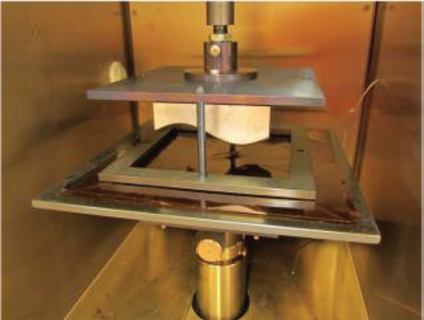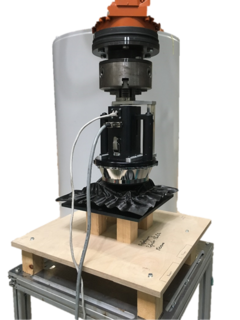MAI Form – Improvement of the Predictive Power for Forming Processes of Composite Materials with Thermoviscous Properties in Large-Scale Production by means of Better Characterization, Simulation, and Validation Methods
Improved models for forming simulation of thermoviscous fiber materials were developed and validated by a standardized comparison with double sinus forming experiments and subsequent measurement of the distribution of fiber orientation.
Project Partners
Automation W+R GmbH, BMW AG, Dassault Systèmes Deutschland GmbH, SGL Carbon GmbH, Voith Composites GmbH & Co. KG
Duration
01.11.2014 – 30.04.2017
Funding authority
German Federal Ministry of Education and Research
Motivation
The project MAI Form focused on the improvement of the predictive power of simulations of forming processes of thermoviscous semi-finished products. Against the background of automobile lagre-scale production, better models for forming simulation and methods for experimental material characterisation and model validation should be established. By means of these improved methods, manufacturing processes can in future quicker be trimmed towards a higher robustness, the use of fiber material can be optimized and development as well as manufacturing costs can be reduced. One possibility to get from a thorough process understanding to higher process robustness is a numerical simulation of these processes and an investigation of process influencing factors. Simulation models for forming as well as heating and cooling processes needed to be developed and a linked simulation chain was required. The goal of this project was to realize the simulation chain in a single software tool in order to ensure the applicability in development processes of the automobile large-scale production.


Method
Within this project, the Chair of Carbon Composites had the task to establish and further develop methods for simulating the forming process of composite semi-finished products as well as the development of new improved testing methods for material forming. By means of a MATLAB routine, simulation results were systematically compared to experimental results. The following essential findings could be achieved:
- Dynamic experiments could allow a representation of higher strain rates if they were conducted outside the linear viscoelastic regime
- The new material data set MAT 140 from 2015 in PAM-FORM 2G (ESI GmbH) facilitates the modelling of the semi-finished product because properties at given temperatures and strain rates can be inserted tabularly as stress-strain data.
- Suitable friction models are necessary for the modelling of fiber reinforced thermoplastics. Frictional models need to account for a dependency on fiber orientation and may also consider dependencies on termperature, pressure and velocity.
Publications
Margossian, A.; Bel, S.; Hinterhölzl, R.: On the characterisation of transverse tensile properties of molten unidirectional thermoplastic composite tapes for thermoforming simulations. Composites Part A: Applied Science and Manufacturing 88, 2016, 48-58
Margossian, A.; Bel, S.; Hinterhölzl, R.: Bending characterisation of a molten unidirectional carbon fibre reinforced thermoplastic composite using a Dynamic Mechanical Analysis system. Composites Part A: Applied Science and Manufacturing 77, 2015, 154-163
Margossian, A.; Hörmann, P.; Zemliana, K.; Avila Gray, L.; Bel, S.; Hinterhölzl, R.: Shear characterisation of unidirectional thermoset pre-impregnated composites using a rheometre. 19èmes Journées Nationales sur les Composites, 2015
Margossian, A.; Reger, A.; Singh Pardeshi, B.; Bel, S.; Hinterhölzl, R.: Interply Slip Characterisation in Thermoplastic Laminates for the Devel-opment of FE Thermoforming Simulations. Proceedings of the 13th International Conference on Flow Processes in Composite Materials (FPCM), Kyoto, Japan, 2016
Acknowledgement
The chair thankfully acknowledges the funding of the project “Verbesserung der Prognosefähigkeit für Umformprozesse von Verbundwerkstoffen mit thermoviskosen Eigenschaften in Großserienanwendungen durch verbesserte Charakterisierungs-, Simulations- und Validierungsmethoden – MAI Form” provided by the German Federal Ministry of Education and Research under the leading edge cluster MAI Carbon (funding code: 03MAI22F).



Contact Persons
Dr.-Ing. Swen Zaremba
Final Report
External link (pdf)